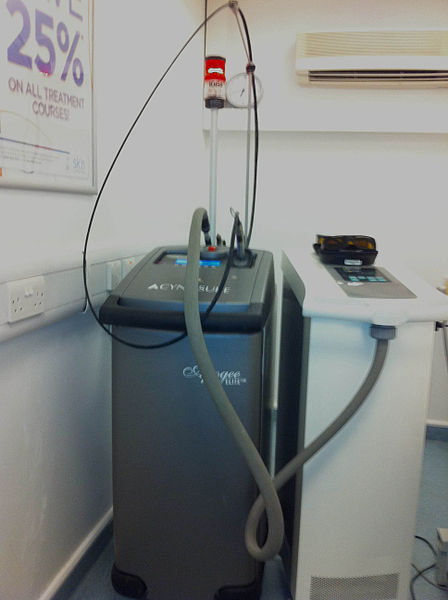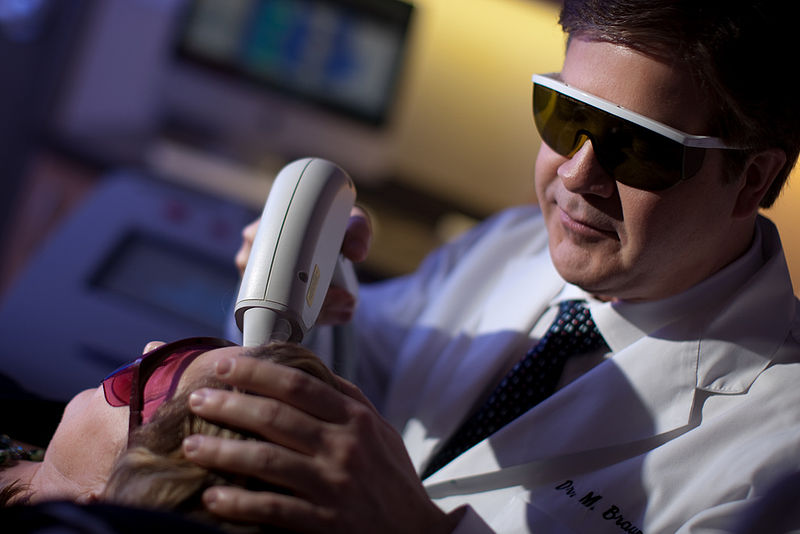Laser Hair Removal
On May 19, 2014
More and more people are opting for laser hair removal for its lasting effects over traditional hair removal methods. Men and women alike choose this method for different reasons but ultimately want the same thing; removing unwanted hair. This article will discuss the process of laser hair removal and may possibly unveil some details that are not as widely known about the process.
Let’s go over the basics of laser hair removal
During the process of laser hair removal, a laser beam passes through the skin to an individual hair follicle. The beam of light at a specific wavelength targets melanin in the hair and at the hair follicle growth center; known as the hair bulb. Melanin is the material that gives color to our hair and skin. The laser beam is absorbed by the melanin in the hair follicle. The intense heat of the laser damages the hair follicle, thereby inhibiting future hair growth.

Types of lasers used in laser hair removal
There are five different types of lasers that may be used for laser hair removal.
1. Ruby laser. This laser is the oldest type of hair removal laser. It is limited by the fact that it covers a small treatment area, thereby requiring more treatments to removal larger areas of unwanted hair. This laser is best used to removal fine and light hair and it is not optimal to use on dark or tanned skin. These limitations have caused this laser to become less popular in recent years.
2. Alexandrite laser. The Alexandrite is the most commonly used laser as it is good for treating large body areas in patients with light-to-olive complexion. Another feature with this laser is that it is the fastest among all of the lasers that can be used. The versatility of this laser provides flexible pulse widths and energy densities that offers the right combination of treatment parameters. With that said, it can even remove fine or deeper lying hair reliably and with long-lasting results.
3. Long Pulse Nd:Yag laser. This laser can be used on all skin types and has fast repetition rates, allowing large areas to be treated. Fast repetition rates allow for brisk treatment of large body areas. This laser can, however, cause more pain and discomfort during treatment than the other lasers.
4. Intensed Pulse Light or IPL device. These devices are not lasers, but are “laser equivalents” in the sense that they use the same concept of selective photothermolysis to complete hair removal. IPL devices are more difficult to use than lasers and require a very skilled and experienced technician to operate. Benefits for using this method include a less painful experience during and after the treatment and effectiveness on all skin types.
5. Diode laser. This laser works best on darker skin types. It has fast repetition rates and therefore can cover larger areas of skin. This laser is less effective on lighter, finer hair. This laser was found to have greater side effects than IPL and Alexandrite lasers in a 2006 review article in the journal “Lasers in Medical Science.” While the review found no differences in effectiveness among the 3 laser devices (approximately 70% hair reduction after 6 months), side effects were reported as 28.9% for diode lasers, 15.3% for IPL, 9.5% for Alexandrite lasers.
Preparation for laser hair removal
There are several things that you can do to serve as preparation before your initial laser hair removal appointment. First and foremost, researching a reputable doctor is key to insuring a positive

procedure. Once you decide on a doctor, be sure to discuss a treatment plan and related costs as laser hair removal is typically an out-of-pocket expense. Prior to getting laser hair removal, we recommend staying out the sun and avoiding tweezing, waxing, and electrolysis. These hair removal methods can disturb the hair follicle and interfere with laser hair removal. Staying out of the sun can decrease certain side effects such as skin lightening and therefore patients are recommended to stay out of the sun up to six weeks prior the the procedure.
Risks to consider before going under the laser
Despite the seemingly benign nature of laser hair removal, there are certain risks that must be taken into consideration before setting foot into the doctor’s office. Possible side effects may include pain, scarring, swelling and pigment changes. Although a burning sensation may be felt an hour or two after laser hair removal treatment, it is usually transient and goes away on its own. Scarring is a rare possible side effect but can be avoided with the proper precaution. It can occur if the wrong type of laser is used at an incorrect setting. The treated areas may experience pigment changes, either skin darkening or skin lightening. Sun exposure must be avoided if a darker spot occurs, as that may intensify the hyperpigmentation. Skin lightening generally affects individuals with a darker skin tone. Nevertheless, pigment changes are usually temporary and the skin pigment eventually returns to normal.
What you need to know after your laser hair removal session.
After your session, the treatment area may appear to be swollen and have a red tint. This should only last for a few hours and may be alleviated by over-the-counter pain relievers, aloe gel, or steroid cream. Aloe Vera is known to reduce the burning sensation due to sunburn and it could be beneficial to apply it to the treated area if you feel a burning sensation. If you have a skin reaction immediately after laser hair removal, such as blistering, the doctor might apply a steroid cream to the affected area. While healing from laser hair removal, wash your skin gently with soap and water. Avoid picking at or vigorously scrubbing the affected skin. It is recommended to avoid sun exposure; both natural sunlight and tanning beds (which should not be used by anyone regardless). When your skin has healed, use sunscreen and use sun protective measures whenever you're in the sun. One thing to look out for is possible shedding. Some might mistake this as hair regrowth but it is considered a normal side effect from treatments.
In conclusion, laser hair removal is a detailed process and it should be researched just as any other medical procedure. It is important to consider the possible side effects and whether or not the outcome is worth the time and money. We encourage you to read further about laser hair removal in order to decide whether it is a good choice for you. For more information regarding other methods of hair removal, please read our article, Hair Removal Methods.

Katherine Giesen is a freelance multimedia writer and editor and currently is one of the assistant editor interns at Central Skin. She was born and raised in South Jersey and studied broadcast journalism in Florida. In addition to her interests in skin health, Katherine has a background in the culinary arts. Through her passions and interest, she wants to enrich the lives of others.


Comments
Leave a Comment